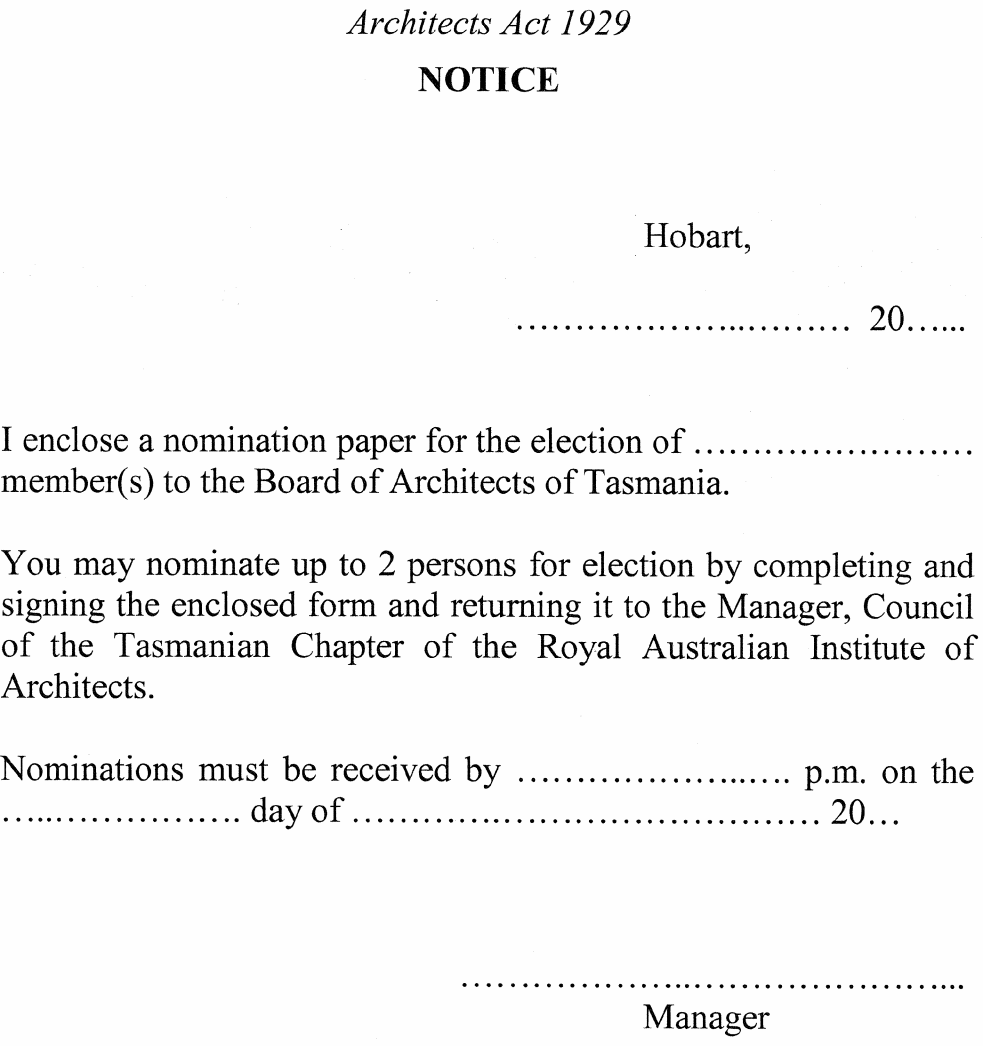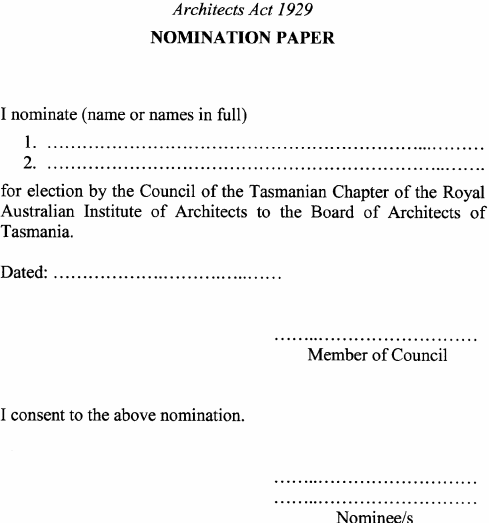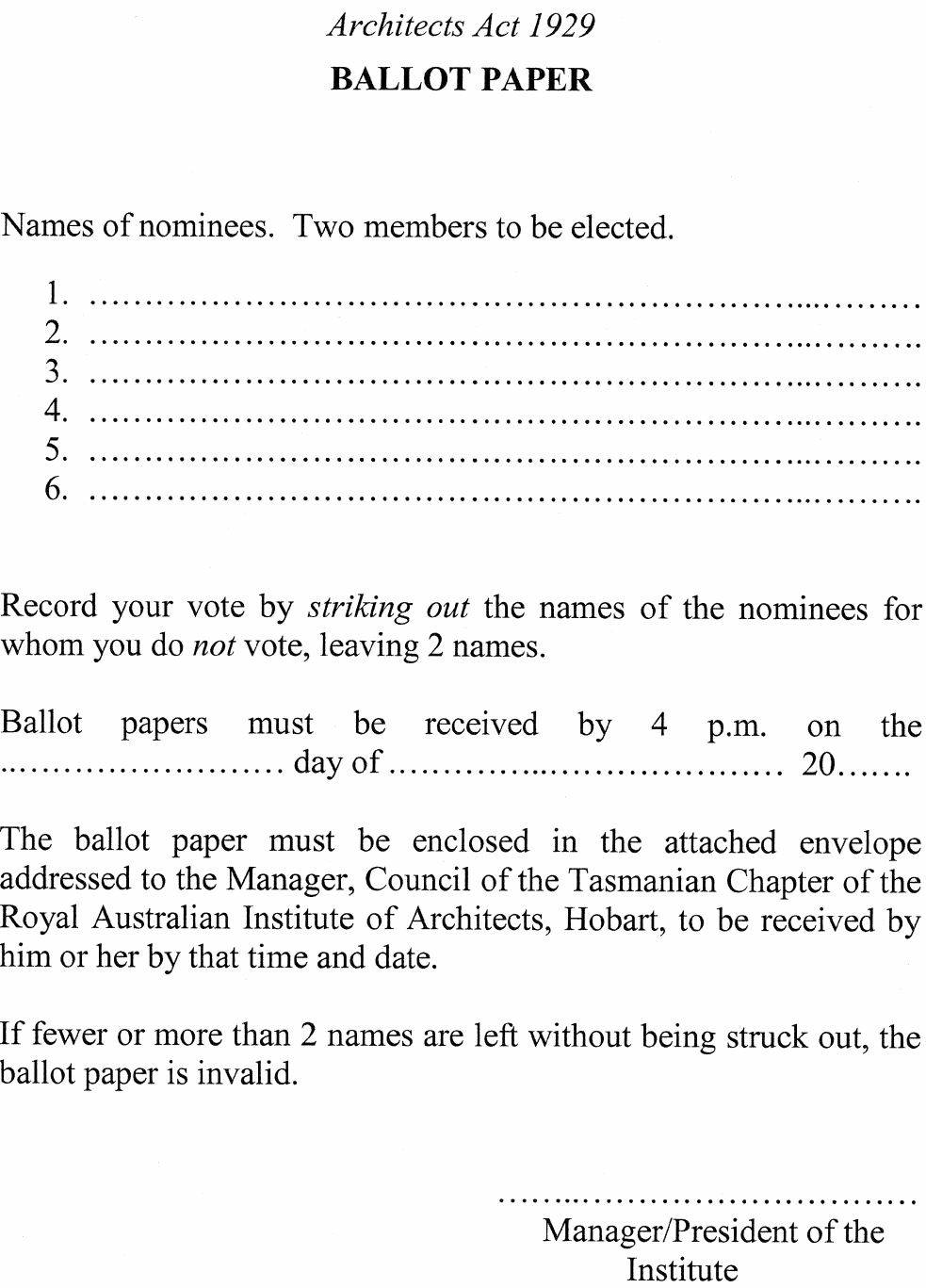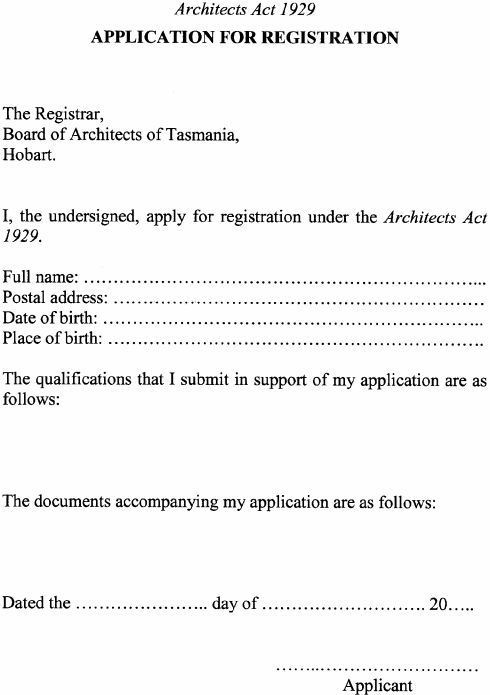Architects Regulations 2008
I, the Governor in and over the State of Tasmania and its Dependencies in the Commonwealth of Australia, acting with the advice of the Executive Council and upon the recommendation of the Board of Architects of Tasmania, make the following regulations under the Architects Act 1929 .
24 November 2008PETER G. UNDERWOOD
Governor
By His Excellency's Command,
G. L. STURGES
Minister for Infrastructure Acting for and on Behalf of the Minister for Planning and Workplace Relations
PART 1 - Preliminary
These regulations may be cited as the Architects Regulations 2008 .
These regulations take effect on 1 January 2009.
In these regulations –Act means the Architects Act 1929 ;chairperson means the chairperson of the Board;committee means a committee referred to regulation 29 ;council means the council of the Institute;election means an election referred to in regulation 4 or regulation 5 ;election day means a day appointed under regulation 4 or regulation 5 ;manager means the manager of the council;nominee means a person nominated for election under regulation 7 ;vote-counting meeting means a meeting under regulation 15(1)(a) .
PART 2 - Elections
An election for the purposes of section 4(1)(c) of the Act is to be held –(a) on a day appointed by the council; and(b) within one month before the end of the term for which a member has been elected; and(c) in accordance with these regulations.
An election for the purposes of section 4(5) of the Act is to be held –(a) on a day appointed by the council; and(b) in accordance with these regulations.
The manager, at least 14 days before election day, is to deliver or send to each member of the council –(a) a notice in accordance with Form 1 ; and(b) a nomination paper in accordance with Form 2 .
(1) A member of the council may nominate up to 2 practising architects for election to the Board by –(a) completing a nomination paper; and(b) delivering or sending it to the manager.(2) The manager is to refuse to accept a nomination paper that –(a) is received less than 10 days before election day; or(b) does not contain the written consent of a nominee.
8. Meeting to deal with nominations
The council is to hold a meeting to deal with nominations (referred to in this Part as the "nominations meeting").
(1) This regulation applies if the number of nominees for an election is equal to or less than the number of vacancies.(2) The council, by resolution at the nominations meeting, is to declare any nominee or nominees elected.(3) Subject to subregulation (2) , the council, by resolution at the nominations meeting, is to elect the required number of persons to fill any vacancies.(4) The council is to elect only those persons who consent to be elected.(5) The council is to cause notice of the making of the declaration or election to be published in the Gazette.
10. Election after nominations meeting
An election after the nominations meeting is to be held if the number of nominees is greater than the number of vacancies.
(1) Within 7 days before election day, the manager is to deliver or send to every member of the council –(a) a ballot paper; and(b) an envelope for the return of the ballot paper.(2) A ballot paper is to be –(a) in accordance with Form 3 ; and(b) signed by –(i) the President of the Institute; or(ii) the manager.
A member of the council may vote at an election by –(a) striking out the names of all but 2 nominees on the ballot paper; and(b) placing the ballot paper in the envelope provided; and(c) delivering or sending the ballot paper to the manager.
(1) The ballot for an election closes at 4 pm on election day.(2) The manager is to reject a ballot paper received after that time.
On receipt of the ballot papers, the manager is to –(a) place them unopened in a box; and(b) secure the box with a lock.
(1) As soon as practicable after the close of the ballot, the council is to –(a) notify the nominees that a meeting is to be held for the purpose of counting votes; and(b) appoint a returning officer; and(c) hold a meeting.(2) At the vote-counting meeting, the returning officer is to –(a) open the locked box containing the ballot papers; and(b) take the ballot papers out of the envelopes; and(c) examine the ballot papers; and(d) count the votes, rejecting those that are informal.
A ballot paper is informal if –(a) it is not signed as specified in regulation 11(2)(b) ; or(b) it has no vote indicated on it; or(c) fewer or more than 2 names are left on the ballot paper without being struck out; or(d) it has upon it a mark or writing that –(i) is not authorised by these regulations; and(ii) in the opinion of the council, may enable a person to identify the voter.
Any nominee may nominate a scrutineer to be present at the vote-counting meeting.
If 2 or more nominees have received an equal number of votes, the council is to determine by lot which of the nominees is elected.
(1) The council, by resolution at the vote-counting meeting, is to declare the result of the election.(2) The council is to cause notice of the making of the declaration to be published in the Gazette.
An election is not invalid because a member of the council –(a) does not receive a ballot paper; or(b) does not receive a ballot paper within the prescribed time.
PART 3 - Proceedings of Board
(1) The first meeting of the Board in any year is to be held at a time and place determined by the Board.(2) Any subsequent meeting of the Board in that year is to be held at a time and place determined by the chairperson.(3) Meetings of the Board or a committee are to be conducted in accordance with this Part.
(1) The chairperson for any year is to be elected at the first meeting of the Board in that year.(2) The chairperson is to preside at all meetings of the Board.(3) In the absence of the chairperson from any meeting or part of any meeting of the Board, the other members present are to choose one of their number to preside at that meeting or for part of that meeting.(4) Any member presiding at a meeting of the Board has, and may exercise, all the powers and authorities of the chairperson.
(1) A notice convening a meeting of the Board or a committee is to be –(a) in writing; and(b) delivered or sent by the Registrar to each member of the Board or committee at least 7 days before the meeting is to be held.(2) A notice under subregulation (1) may be delivered or sent to a member by –(a) leaving it at, or sending it by post to, the member's postal address; or(b) faxing it to the member's fax number or emailing it to the member's email address.(3) Anything done or agreed to be done at a meeting of the Board or a committee is not invalid because –(a) a member of the Board or committee did not receive a notice of that meeting; and(b) as a result of non-receipt of the notice, that member was not present at the meeting.
(1) A member present at a meeting of the Board is eligible to vote at that meeting.(2) A question arising at a meeting of the Board is to be decided by –(a) open voting; and(b) a majority of votes.(3) If a member abstains from a vote, a vote in the negative is attributed to that member.(4) If there are equal votes on any question, the chairperson has a casting vote.(5) The chairperson has a deliberative vote.
(1) The chairperson may adjourn a meeting of the Board.(2) If a quorum is not present within half an hour after the time appointed for a meeting, the members present, or the Registrar if no member is present, may –(a) adjourn the meeting; and(b) arrange for that meeting to be held not later than 7 days after the day on which the meeting was adjourned.
The Registrar is to call a special meeting of the Board if requested to do so by –(a) the chairperson; or(b) any 3 members of the Board.
The Board is to ensure that accurate minutes of proceedings at meetings of the Board and its committees are kept by the Registrar.
28. Rescission or amendment of previous resolutions
An act done or authorised to be done, or resolution passed, by or at a meeting of the Board may not be rescinded or amended at a subsequent meeting of the Board unless –(a) notice of the intended rescission or amendment is given in the notice convening that meeting; and(b) the rescission or amendment is passed by that meeting.
(1) The Board, by resolution, may –(a) appoint for a special purpose a committee of 3 members, including the chairperson; and(b) dissolve that committee.(2) The chairperson is to preside at any meeting of a committee.
30. Authentication of documents
A document issued by the Board under the Act or these regulations has the authority of the Board if it is signed by –(a) the Registrar; or(b) any 2 members.
PART 4 - Duties of Registrar
(1) The Registrar is to undertake any duties the Board directs.(2) The Registrar is responsible for the safe custody of –(a) the seal of the Board; and(b) all documents and property belonging to the Board.
The Registrar is to keep the register of architects at the office of the Board.
(1) The Registrar is to pay money received by the Board or the Registrar into the funds of the Board within 7 days after the money is received.(2) For the purposes of section 23 of the Act, the Registrar is to prepare and present to the Board at the end of each year a statement showing the receipts and disbursements of the Board during that year.
PART 5 - Registration
34. Application for registration
(1) An application under section 14(1) of the Act is to be –(a) in accordance with Form 4 ; and(b) accompanied by a fee of –(i) if the applicant sits for a practice examination immediately before applying for registration, 18 fee units; or(ii) in any other case, 50 fee units.(2) The Board may require an applicant to –(a) attend personally before the Board; and(b) answer any oral or written questions put by the Board.(3) In this regulation –practice examination means the architectural practice examination set by the Architects Accreditation Council of Australia.
35. Certificate of registration
A certificate of registration under section 15 of the Act is to be –(a) in accordance with Form 5 ; and(b) only issued on the payment by the applicant for registration of a fee of 10 fee units.
For section 11 of the Act, the prescribed registration fee is 45 fee units.
(1) The Board, by notice in writing, may require a person whose name is removed from the register under the Act to return his or her certificate of registration to the Board.(2) A person referred to in subregulation (1) , or the executor, administrator or trustee of that person, is to return the certificate of registration to the Board within 14 days after receiving the notice referred to in subregulation (1) .
PART 6 - Miscellaneous
A person who, immediately before the day on which these regulations take effect, was a member of the Board under the Architects Regulations 1997 continues on and from that day to be a member of the Board until the member's term of office expires.
SCHEDULE 1 - Forms
Form 1
Form 2
Form 3
Form 4
Form 5
Displayed and numbered in accordance with the Rules Publication Act 1953.
Notified in the Gazette on 3 December 2008
These regulations are administered in the Department of Justice.






